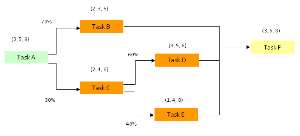Risk management - Multiple branching part 2
Multiple branching part 2
In this case, we have an initial branch of 70% to Task B and 30% to Task C and within the second branch we have another branch of 60% to Task D and 40% to Task E.
The mechanism for the calculations in the spreadsheet is similar to the previous example [see complex branching].
Task B and Task C both begin at the same time of 5.3 weeks, which is the finish time for Task A.
At the first branch there is only Task B which will have a duration of:
Task B: (0.7 x 3.3) + 5.3 = 2.3 + 5.3 = 7.7 (when accurately calculated to one decimal place).
For Task C we have:
Task C: (0.3 x 4.0) + 5.3 = 1.2 + 5.3 = 6.5.
For this case, both Task D and Task E start at the same time, which is the end of Task C = 6.5 weeks.
So, we have:
Task D: (0.18 x 4.7) + 6.5 = 0.9 + 6.5 = 7.4
Note:
That the probability value of 0.18 derives from 0.3 x 0.6 = 0.18.
Task E: (0.12 x 4.3) + 6.5 = 0.5 + 6.5 = 7.1 (when accurately calculated to one decimal place).
Note:
That the probability value of 0.12 derives from 0.3 x 0.4 = 0.12.
Also, 0.18 + 0.12 = 0.3.
This means that the end of Task B is the latest duration date = 7.7 weeks.
So we have:
Task F: 7.7 + 5.7 = 13.3.
Simulation
The spreadsheet simulation will carry out perhaps 300 to 1000 iterations and each time will firstly set Task A to a value based upon its 3 point estimate.
This will lead to a completion time for Task A which will be the start time of Tasks B and C.
Each of these will in turn have a duration based upon their 3 point estimates affording individual completion dates.
Eventually, there will be a value calculated for the completion date of Task F.
This final completion date will be recorded.
Over many iterations a MONTE CARLO distribution will result having a MINIMUM duration of (3 + [2 ] + 3) = 8 weeks and a MAXIMUM of (8 + [6 + 8] +8) = 30 weeks.
The MINIMUM time is based upon the minimum for Task B (2 weeks) and Task A and F, giving 8 weeks.
The MAXIMUM time is based upon the maxima for Tasks A, C (6 weeks) and Task E (8 weeks) and Task F giving 30 weeks.
From this data a graph of PROBABILITY versus TOTAL DURATION will be formed.
In a similar vein to the ‘cost’ scenario we will be able to, for example, set a ‘total duration’ at which there is a ‘likelihood’ of 20% of it being exceeded.
The TOTAL DURATION added on to the start date of 0.0 will give the project COMPLETION DATE.
In addition, CORRELATED EVENTS could be included as for the ‘cost risk assessment’. For this one would need to identify the INDEPENDENT task and then the DEPENDANT tasks which take their lead from it according to the underlying cause.
As in the previous examples, when looking at the spreadsheet and the mechanism for the iteration it is worth remembering that the probability values will not actually be seen as 0.7 or 0.3 (although the software might possibly be set to show this). This is because the software doesn’t actually provide a value of 0.7. In effect, it will give the pathway through Task B a value of ‘1’ or ‘0’ (ON or OFF). When the value is ‘1’ the software will ignore the alternative pathway (which will be set to ‘0’) and set a value for Task B. This will lead to a calculation of the total duration for the completion of Task F.
In practice the software will set this pathway probability value to ‘1’ approximately 7 times in every 10 iterations, leading to a 70% chance of occurrence.
Naturally, the other pathway (through Task C) will be set in the opposite manner to get a 30% chance of occurrence.





